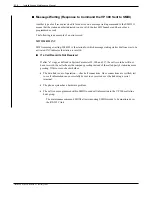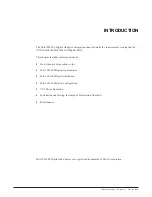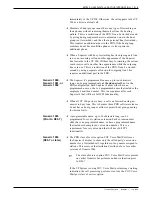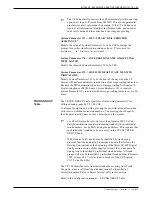
The following information applies only to sub-attendant message waiting indication.
•
The VP 300 must call a phone to control its message waiting indicator. A phone may ring
briefly while the VP 300 turns its indicator ON or OFF.
•
The VP 300 cannot control a phone’s message waiting indicator while that phone is set for
Do Not Disturb, or when that phone forwards on Busy-Forward or All-Forward. Also, the
VP 300 cannot control the message waiting indicator of a Superset 4 with AUTO
ANSWER turned ON. This conflicts with operation of CPI in some instances. For example,
–
If a phone forwards all calls to the VP 300 for secondary answering, the VP 300 cannot
control that phone’s message waiting indicator until the phone is taken out of forward.
The same applies to a phone in Do Not Disturb.
–
If a person logs on from their own phone and the phone is set to forward on busy, the
VP 300 cannot turn that person’s message waiting indicator OFF until the person is off
the phone.
☞
If a phone is set to forward only on ring-no-answer, conflicts such as these do not
occur. Therefore, we recommend setting all extensions that use MWI to forward to
the VP 300 only on ring-no-answer. The drawback to this is that these extensions do
not receive internal call coverage when they are busy.
The following information applies only to COV Voice Mail port message waiting indication.
•
COV Voice Mail port message waiting indication does not require the MIC port to call a
station in order to control its message waiting indicator. Stations may use busy-forward,
all-forward, or do not disturb without any conflict with VP message waiting indication.
•
If a station’s message waiting indicator is activated by a COV voice mail port, the SX-200
Digital automatically extinguishes the indicator when that station calls another COV voice
mail port. This requires that MIC call processing ports not be configured as COV voice
mail ports so that message waiting indication is not cancelled by the PBX when the station
user calls the VP System, but rather by a VP System’s message waiting port when the
station user logs into the VP System mailbox.
•
Since the MIC call processing ports cannot be COV Voice Mail ports, any names
programmed for extensions or trunks on the PBX must contain extension numbers or trunk
numbers according to the Naming Conventions in the Mitel SX-200 Digital Configuration
section of this chapter.
■
PBX Functional Limitations that Affect CPI
The following are limitations that affect Called Party Identification.
■
Caller Identification
Caller identification differs among the various Mitel SX-200 Digital software releases.
These differences have been outlined below for Generics 1000, 1001, 1002, and 1003.
All Generics
• The attendant, or any person using a station, must wait about one
second before releasing a trunk call to a phone that forwards
Toshiba VP Systems
Release 7.1
July, 1994
10.1-8
Installation and Maintenance Manual
Summary of Contents for VP 300
Page 2: ......
Page 10: ......
Page 14: ......
Page 20: ...Toshiba VP Systems Release 7 1 July 1994 ...
Page 52: ...Toshiba VP Systems Release 6 1 February 1993 2 14 Installation and Maintenance Manual ...
Page 56: ...Toshiba VP Systems Release 7 1 July 1994 ...
Page 146: ......
Page 312: ...Toshiba VP Systems Release 7 1 July 1994 ...
Page 314: ......
Page 444: ......
Page 496: ......
Page 542: ......
Page 598: ...Toshiba VP Systems Release 6 1 February 1993 ...
Page 600: ...Toshiba VP Systems Release 6 1 February 1993 ...
















































